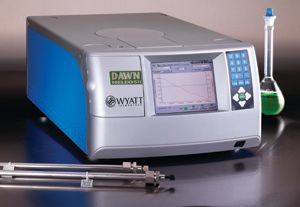SEC-MALS Detector
Based on Wyatt Technology?s legacy of multi-angle light scattering (MALS) detectors, the DAWN HELEOS-II is the MALS detector with the greatest sensitivity for absolute molecular weight and size determinations of polymers and biopolymers in solution. The DAWN may be connected in series to any chromatographic system in order to determine absolute molar masses without the use of reference standards or column calibration.

Based on Wyatt Technology’s legacy of multi-angle light scattering (MALS) detectors, the DAWN HELEOS-II is the MALS detector with the greatest sensitivity for absolute molecular weight and size determinations of polymers and biopolymers in solution. The DAWN may be connected in series to any chromatographic system in order to determine absolute molar masses without the use of reference standards or column calibration.
The HELEOS-II may be ordered with precise sample temperature control from –30° C to 150°, or from ambient to 210° C and can be used with virtually any solvent: aqueous or organic. In addition, the instrument has a bright, 64,000 color LCD display that shows current system states, chromatographic conditions, operating status and more. The instrument incorporates a special 120mW gallium arsenide laser operating at a wavelength of 658 nm. This laser, together with its unique optical collimator, produces light-scattering signals superior to those obtained with any other light scattering instrument.
The DAWN HELEOS-II instruments join Wyatt Technology’s unique light scattering systems which include the miniDAWN TREOS, as well as the Optilab rEX—the only refractive index detector available that can be built to operate at any wavelength selected by the customer.
Contact: Geofrey Wyatt
Tel: 805-681-9009
FAX: 805-681-0123
E-mail: info@wyatt.com
Website:www.wyatt.com
Distinguishing Alcohol- from Non-Alcohol-Associated Liver Cirrhosis with LC-MS
May 7th 2025A pilot study investigating whether nicotinamide adenine dinucleotide kinase (NADK) expression is selectively diminished in alcohol-associated liver cirrhosis (AC), as well as evaluating its potential as a biomarker for this condition, measured AC and non-AC (NAC). Nicotinamide adenine dinucleotide (NAD+) and nicotinamide adenine dinucleotide phosphate (NADP+) levels in human liver samples were measured using liquid chromatography-mass spectrometry (LC-MS).

.png&w=3840&q=75)

.png&w=3840&q=75)



.png&w=3840&q=75)



.png&w=3840&q=75)



